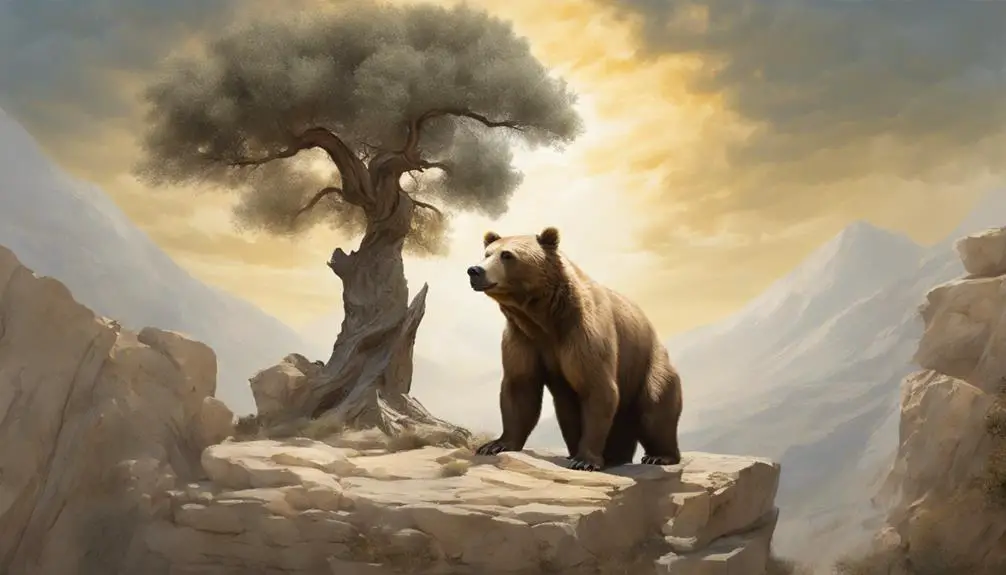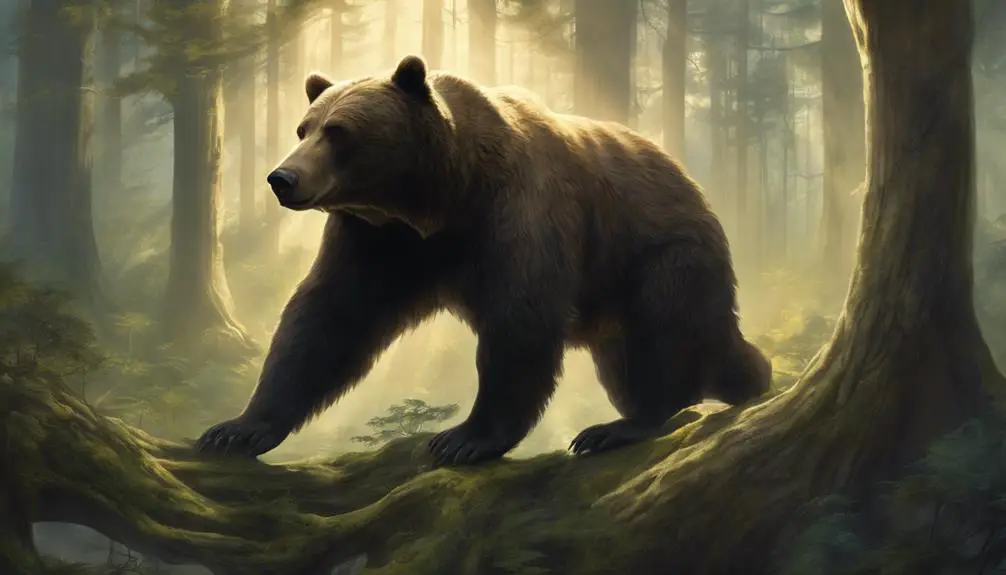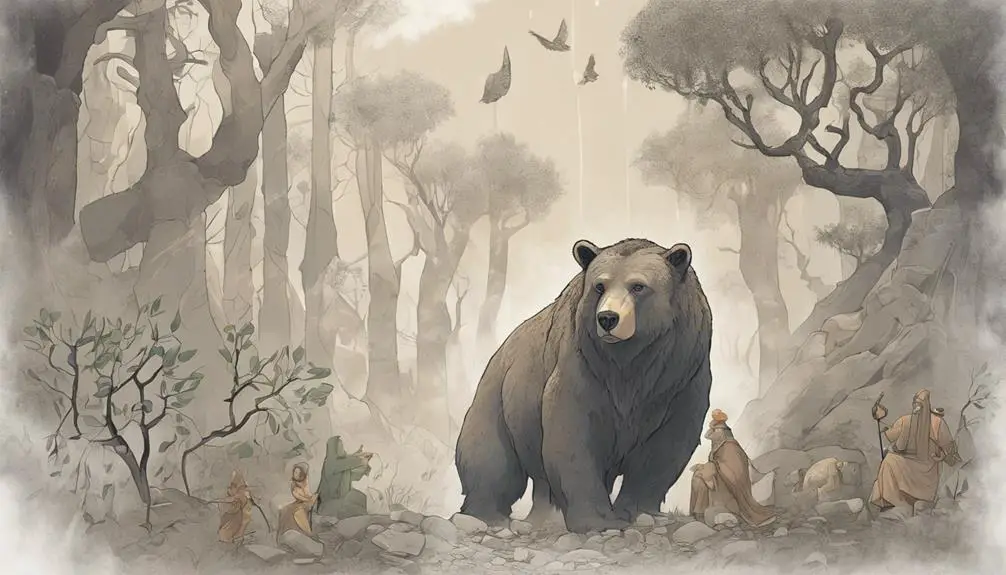Harbinger of divine justice, the she bear in the Bible symbolizes a powerful lesson in respect and consequences, inviting deeper exploration.

What Is a She Bear in the Bible
In the vast expanse of Biblical narratives, the she bear isn't just another animal; it's a force of nature that demands respect and induces awe.
You might wonder how this creature fits into the tapestry of stories known for their profound moral and theological lessons. The she bear makes a memorable appearance that's both chilling and thought-provoking, serving as a catalyst for deeper reflections on divine justice and human behavior.
But to grasp the full significance of this formidable creature, you'll need to explore its symbolic interpretations and the cultural context that shapes its role in the Bible. This journey will uncover layers of meaning that might just change your understanding of the ancient text.
Key Takeaways
- A she bear in the Bible symbolizes divine retribution and the consequences of disrespecting sacred laws.
- Featured in narratives like Elisha's encounter, she bears embody themes of divine justice and protection.
- They represent the manifestation of feminine power and fierce maternal instinct within biblical stories.
- Serve as a narrative device to illustrate moral and theological lessons on reverence and humility.
The She Bear Defined

In biblical context, the term 'She Bear' refers specifically to a female bear mentioned in the narratives of the Old Testament, embodying both literal and metaphorical significance. When you delve into the realm of animal characteristics and geographic distribution, it's essential to understand the she bear's place within the ecosystem and its symbolic representation in biblical texts.
Geographically, bears mentioned in the Bible likely roamed the regions of the Middle East, particularly around areas that are now modern-day Lebanon, Syria, and parts of Turkey. These regions provided suitable habitats for bears, comprising forests and mountainous areas where they could find shelter and food. The climate and geography of these areas supported a variety of wildlife, including bears, making them a part of the natural landscape during biblical times.
The animal characteristics of she bears are pivotal when analyzing their roles in biblical narratives. Bears are known for their strength, ferocity, and protective nature, especially females with cubs. These attributes contribute to the she bear's symbolic meaning, often representing danger, punishment, or divine retribution in biblical stories. Their formidable nature and the instinct to protect their offspring at all costs can be seen as a reflection of divine protection or wrath, depending on the context of the narrative.
Understanding the geographic distribution and animal characteristics of she bears enriches the interpretation of their appearances in the Bible. It provides a foundation for exploring their metaphorical significance and how these majestic creatures influenced the stories and lessons within the Old Testament.
Biblical Appearances

Exploring the biblical appearances of she bears, we find these creatures prominently featured in narratives that underscore their symbolic potency and the lessons derived from their interactions with humans. One of the most notable instances is Elisha's encounter with two she bears in the Book of 2 Kings. This event stands as a stark example of how these animals are woven into the fabric of biblical stories to convey deeper prophetic imagery and moral lessons.
In this account, Elisha, the prophet, is mocked by a group of young boys as he travels to Bethel. They jeer at him, making fun of his bald head, showing a lack of respect not just for him personally but for his prophetic office. In response, Elisha calls down a curse upon them in the name of the Lord, and two she bears emerge from the woods, mauling forty-two of the boys. This severe outcome highlights the seriousness of respecting God's anointed and the consequences of irreverence.
The incident with Elisha isn't just a historical recounting; it's imbued with prophetic imagery that speaks to the power and judgment of God. She bears in this narrative aren't merely animals but agents of divine retribution, emphasizing the gravity of mocking the prophetic voice. Their inclusion in this story serves as a vivid reminder of the respect due to those who speak on behalf of God and the potential consequences of failing to heed this respect.
Through this and other appearances, she bears in the Bible serve as potent symbols within the tapestry of scriptural narratives, illustrating lessons of faith, reverence, and the divine order.
Symbolic Interpretations

She bears serve as multifaceted symbols within biblical narratives, embodying themes of divine justice, protection, and the consequences of irreverence toward the sacred. These creatures, though perhaps surprising to some as spiritual symbols, carry deep layers of meaning, especially when considering their roles through the lens of feminine power and animal symbolism.
Understanding the symbolic interpretations of she bears in the Bible offers a unique perspective on how ancient texts knit the natural world into spiritual teachings. Here are three key insights:
- Feminine Power: She bears in biblical stories often manifest as protectors, embodying a fierce maternal instinct. This portrayal aligns with broader themes of feminine power within the text, suggesting a divine respect for the strength and authority of women. It's a powerful reminder of the respected position women hold within the fabric of spiritual narratives.
- Divine Justice: Often, the appearance of a she bear symbolizes an immediate, uncompromising form of divine justice. This suggests that the natural world, including its most formidable creatures, operates under the guidance of a higher moral and spiritual order.
- Consequences of Irreverence: The presence of she bears also serves as a stark warning against disrespecting sacred laws and figures. It's a vivid illustration of how actions against the divine can lead to swift and severe consequences, reinforcing the importance of reverence and humility.
Analyzing the symbolisms attached to she bears enriches one's understanding of biblical messages, illustrating how the ancient texts use animal symbolism to weave complex moral and spiritual teachings.
Cultural and Historical Context

Understanding the symbolic interpretations of she bears sets the stage for examining their role within the broader cultural and historical contexts of biblical times. In these ancient societies, animal symbolism was deeply ingrained in the fabric of daily life and spiritual understanding. She bears, in particular, held a unique place in this tapestry of ancient beliefs, representing both the nurturing and the ferocious aspects of nature.
To grasp the significance of she bears in these contexts, it's essential to appreciate how people in biblical times viewed the natural world. They didn't see animals merely as creatures roaming the earth but as integral elements of a divine creation, each bearing messages from the spiritual realm. The she bear was no exception. Her dual role as a caregiver and a fierce protector provided a powerful symbol of the divine's protective and punitive aspects.
Diving deeper into the cultural backdrop, these ancient communities often relied on the natural world for their metaphors, drawing from their observations to explain complex concepts. In this light, the she bear's appearance in biblical narratives wasn't just a random choice. It was a deliberate selection, aimed at conveying messages that resonated with the audience's understanding and experiences.
Furthermore, the inclusion of she bears in these stories reflects the broader ancient beliefs in the interconnectedness of all life forms. It underscores a recognition of the parallels between human and animal behaviors, and by extension, a deeper acknowledgment of the unity of creation. This perspective was essential for imparting moral and spiritual lessons, grounding them in the familiar while pointing beyond to the divine.
Moral and Theological Lessons

Delving into the role of she bears in biblical narratives reveals profound moral and theological lessons that resonate with both ancient and modern audiences. These stories, while sometimes startling, serve as vivid illustrations of divine retribution and the consequences of human behavior, providing clear moral compasses for readers.
The narratives underscore several key takeaways:
- Respect for the sacred: The tales often highlight the importance of respecting what's considered holy or divine. Disrespect towards prophets or the divine order is met with severe consequences, illustrating the gravity of such actions in the eyes of the divine.
- Consequences of actions: At the heart of these stories is the theme that one's actions have consequences. Whether it's mocking a prophet or engaging in behavior deemed inappropriate, the resulting divine retribution serves as a stark reminder of this truth.
- Divine sovereignty: The involvement of she bears, acting under divine command, emphasizes the sovereignty of the divine will. It's a reminder that beyond human understanding and control, there exists a higher order that governs the moral and natural world.
Analyzing these narratives through an objective lens, it's clear that they aren't merely historical accounts or folklore. Instead, they serve as theological constructs designed to instruct on the nature of divine retribution and human behavior. By presenting extreme scenarios involving she bears, the texts drive home the message that actions aligned against divine commandments or societal norms carry heavy consequences. This understanding encourages reflection on personal behavior and the importance of aligning with moral and divine principles in one's life.
Frequently Asked Questions
How Has the Depiction of She Bears in the Bible Influenced Modern Environmental or Wildlife Conservation Efforts, if at All?
You might wonder how ancient texts influence today's conservation efforts. While the Bible's depiction of she bears doesn't directly drive modern environmental actions, it's part of broader wildlife symbolism that shapes cultural attitudes towards nature.
This symbolism can subtly affect public and policy-makers' views, potentially impacting conservation challenges. However, the connection isn't straightforward and relies more on the cultural significance of animals than on specific biblical narratives.
Are There Any Notable Artistic Representations of the She Bear Incidents in the Bible Found in Contemporary or Historical Art?
You'll find that artistic representations of the she bear incidents from the Bible aren't widely common, but they do exist. Medieval illustrations occasionally delve into these narratives, embedding rich artistic symbolism within their depictions.
These artworks not only reflect the period's interpretative approaches but also offer insights into the societal values and religious beliefs of the time. Analyzing these pieces, you'll uncover a layer of historical and cultural significance that's often overlooked.
How Do Modern Interpretations of the She Bear Stories Differ Across Various Christian Denominations?
You'll find that modern interpretations of these stories vary widely due to denominational differences. Each Christian group brings its own perspective, influenced by its doctrines and teachings.
Over time, there's been an interpretive evolution, reflecting changes in societal values and theological understandings. Some denominations might emphasize the moral or symbolic lessons, while others could focus on literal interpretation or historical context, showcasing how diverse the Christian faith can be in understanding biblical narratives.
What Psychological Interpretations Have Been Proposed Regarding the Human Interaction With She Bears in Biblical Narratives?
You're delving into how human interactions with she bears in biblical narratives offer a rich ground for psychological interpretation. Experts suggest that bear symbolism, particularly in these stories, might represent maternal aggression, reflecting deeper societal views on motherhood and protection.
This angle offers a fascinating insight into the human psyche, shedding light on how ancient cultures perceived threats and the protective instincts attributed to motherhood, encapsulated within these powerful animal figures.
Can Parallels Be Found Between the Biblical She Bear Stories and Similar Narratives in Other Ancient Cultures or Religious Texts?
Yes, you can find mythological parallels between she bear stories in the Bible and narratives from other ancient cultures. These tales often share cultural symbolism, reflecting universal themes of protection, strength, and motherhood.
Conclusion
In sum, the she-bear in the Bible, especially noted in the story from 2 Kings, isn't just a tale of divine retribution but a symbol rich in cultural and moral significance.
Interestingly, among the animal mentions in the Bible, bears are highlighted less than 10 times, underscoring the unique impact of this story. Analyzing it sheds light on the complexities of biblical teachings, offering insights into the interplay between divine justice, societal values, and the natural world.
This narrative invites you to delve deeper into the layers of biblical storytelling, revealing the multifaceted ways in which ancient texts engage with themes of morality and justice.



Sign up